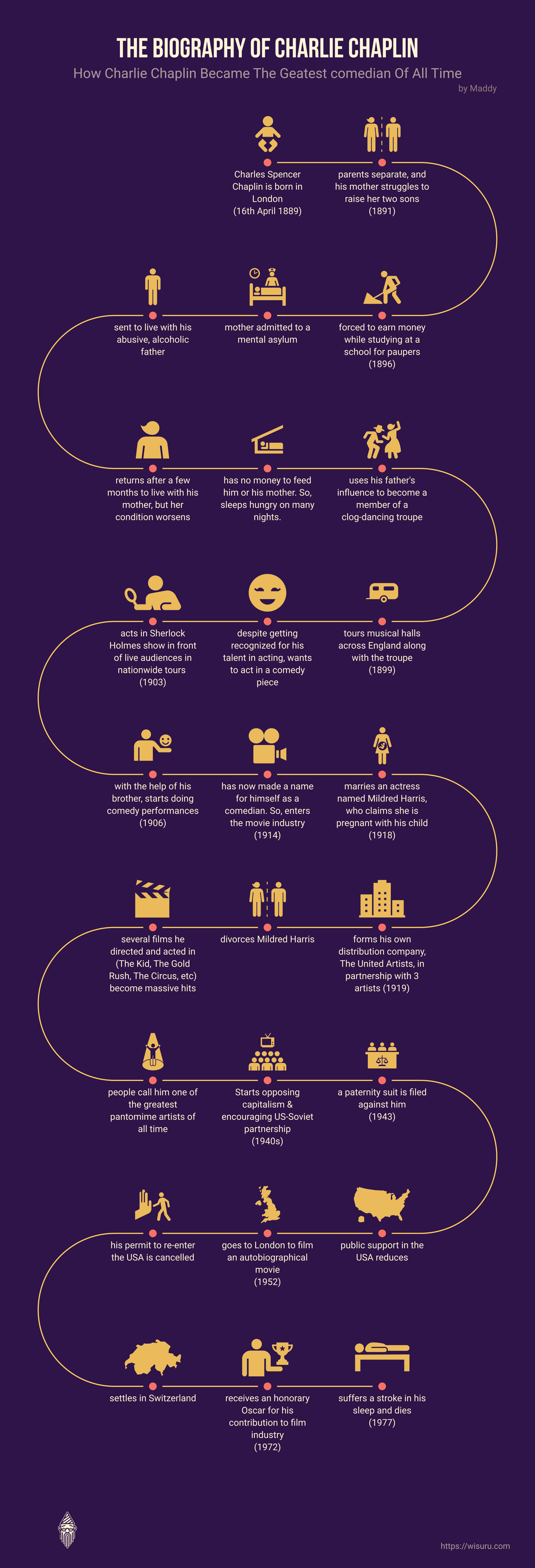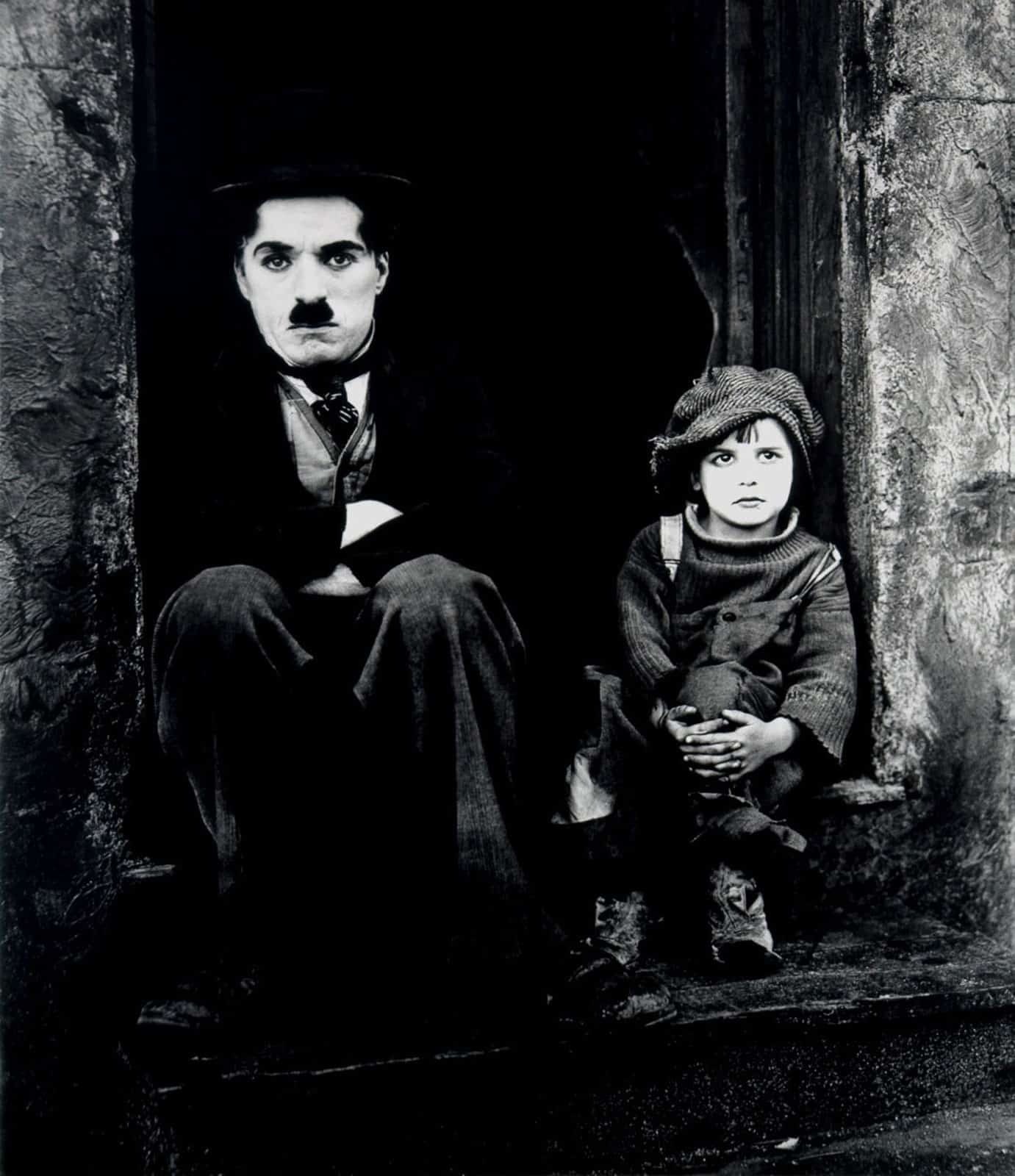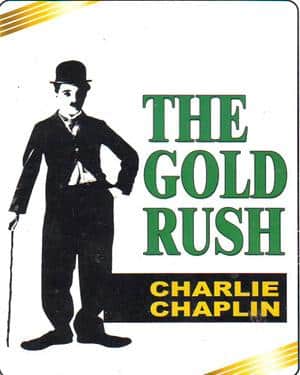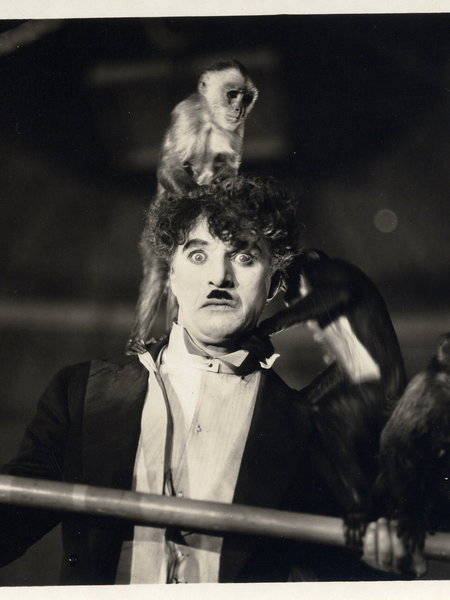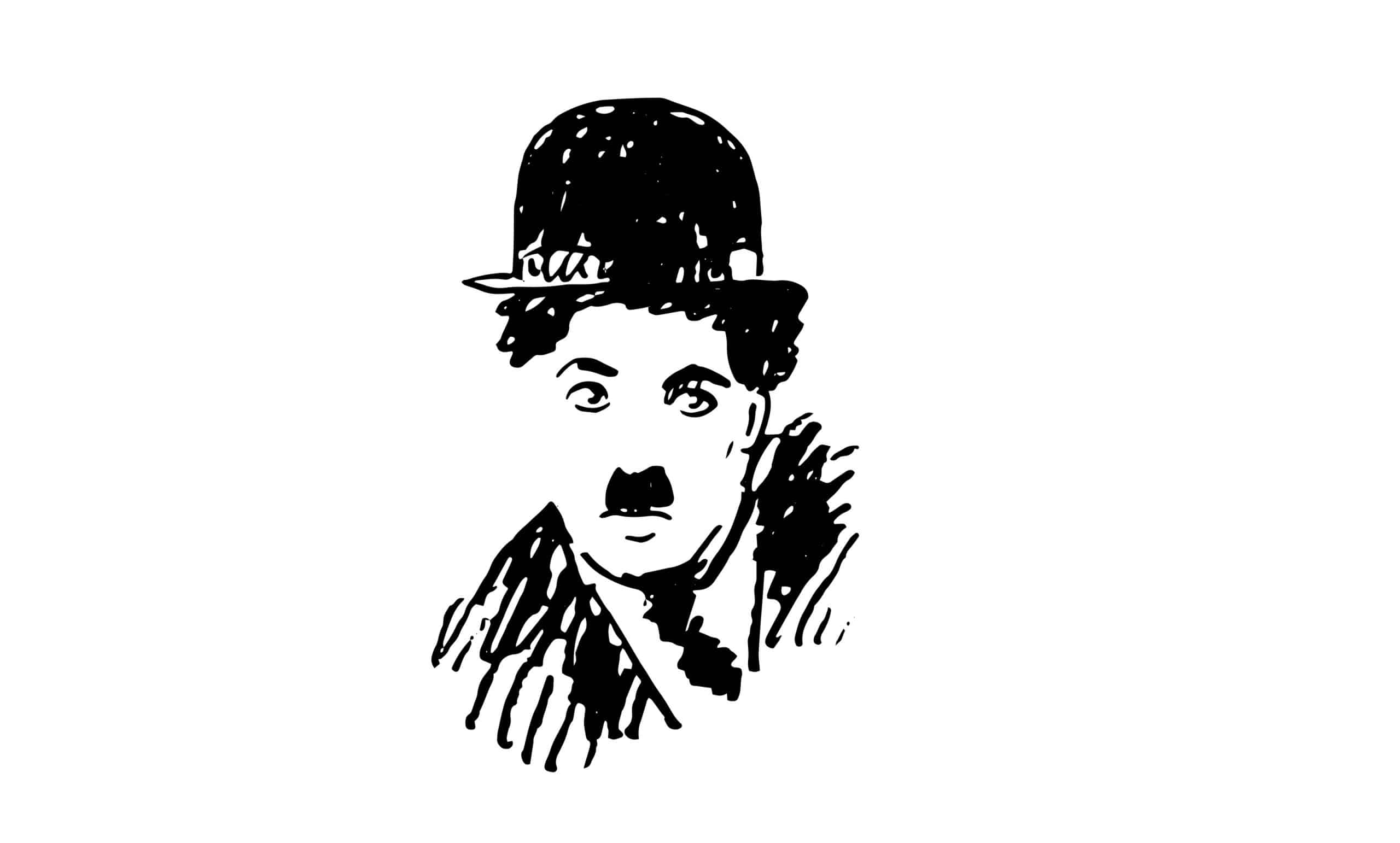This blog post is a biography of Charlie Chaplin. Charlie Chaplin was an English comedian, writer, director, producer, and composer. He rose to fame because of his comic timing and on-screen persona that floored his audience. His career spanned 75 years. During this time, he got a lot of admiration from his fans.
'The Tramp,' the little man with a weird mustache, a bowler hat, and shoes, who used quirky movements and pantomime, was the central character in most of his films. This iconic character revolutionized the film industry like none other.
Even though Charlie became world-famous, he was not born with a silver spoon. He had a very rough childhood. As a child, he suffered from poverty and a lack of love.
“To truly laugh, you must be able to take your pain, and play with it.” – Charlie Chaplin (Source)
This article takes you into the world of Charlie Chaplin, who, with his perseverance, passion for acting, and the desire to succeed, earned a permanent place in global cinema and people's hearts.
Birth
Charlie Chaplin was born in London on 16th April 1889 to Hannah Chaplin and Charles Chaplin Sr. His birth name was Charles Spencer Chaplin. He was the second son to his mother and first son to his father.
His parents, both music hall entertainers, separated when he was 2 years old. After that, his mother struggled financially to raise her two sons without any support from her husband.
Childhood in poverty
Charlie's life trajectory can be called one of the most dramatic 'Rags to Riches' story. His early years were filled with difficulties at every step. At the age of 7, he was forced to earn money while studying at a school for paupers.
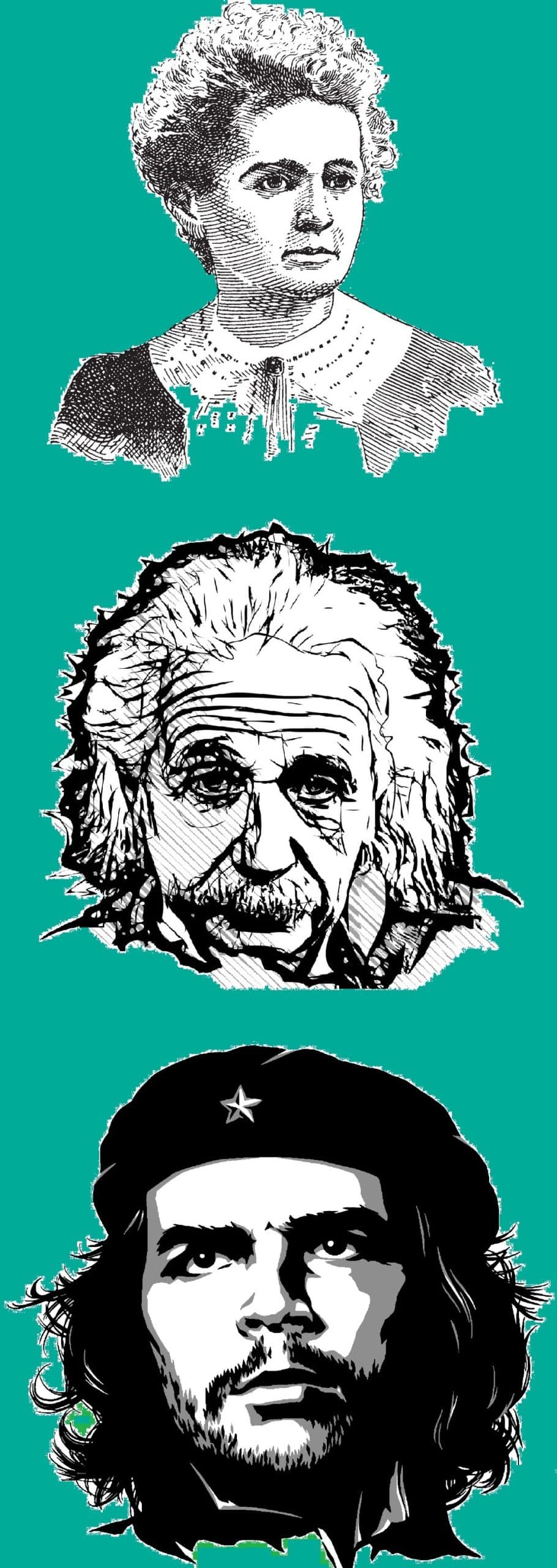
A Titbit About A GREAT Personality In Your Inbox Everyday
Find out how people changed our world and made history while doing it. Find out what motivated them to become their best self. Find out how they found innovative solutions to impossible problems.
Get a peek into the life of a great personality every day.
To add to his problems, his mother developed a psychological condition due to malnutrition. So, she was admitted to a mental asylum. Since their mother couldn't take care of them, the two brothers were sent to live with their father.
Their father was a severe alcoholic who would often beat them. Even though they lived there for just two months, it was a horrible experience for them.
After they returned, their mother's condition worsened day by day. So, young Charlie had to sleep hungry on many days when he could not earn anything.
“I was hardly aware of a crisis because we lived in a continual crisis; and, being a boy, I dismissed our troubles with gracious forgetfulness.” – Chaplin on his childhood (Source)
How Charlie got into acting
It is during this time that Charlie began performing on stage by chance. He became interested in stage performances to take his mind away from his unfortunate life and his mother's condition.
Charlie's mother encouraged him to keep performing on stage.
“She made me believe that I had some sort of talent,” Charlie said.
So, in between his school sessions and spending time with his mother, Charlie started to perform regularly.
He became a member of a clog-dancing troupe, which toured the halls of England to perform. He worked very hard to gain popularity among the masses.
Venturing into comedy:
Though Charlie was getting a lot of good work in musicals, he wanted to perform a comedy piece. His first comedy act was in the show "Jim," directed by Harry Saintsbury. The show was not very successful, but Charlie was praised by many for his distinguished performance.
By this time, Charlie had abandoned his education and had become a full-time entertainer.
Charlie then acted in the "Sherlock Holmes" show in front of live audiences in nationwide tours.
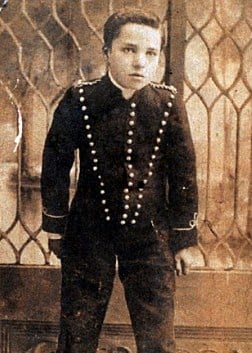
A teenage Charlie in the play Sherlock Holmes - By Unknown author - Image is included in Chaplin: Stage by Stage by A J Marriot, p. 48, Public Domain, Link
He performed his role so brilliantly, that he was called to London to perform the same role alongside William Gillette, the original Holmes.
Sydney, Charlie's half-brother, was also working full time in comedy sketches by this time. He helped Charlie in getting some prominent comedy roles.
Reviewers called Charlie "one of the greatest pantomime artists" they had ever seen!
After a series of successful comedy shows on stage, Charlie entered the movie industry in 1914 and signed a deal with Keystone Studio. He worked with several big film studios throughout his career.
Forming his own distribution company
Charlie always wanted to have full control and freedom over his films and their distribution. He was also concerned about the quality the big studios were lacking. So, he formed his own distribution company, United Artists, in partnership with three other artists.
First marriage
Before the company was founded, Charlie married an actress named Mildred Harris, who claimed she was pregnant with his child. So, they got married very quietly, and the pregnancy turned out to be fake.
Charlie had married Mildred only because he thought she was pregnant. When he found out she wasn't actually pregnant, he became quite unhappy with the marriage. He actually became a father on 7th July 1919, but his son was born deformed and died three days later. Finally, Charlie ended the marriage in the year 1920, citing irreconcilable differences.
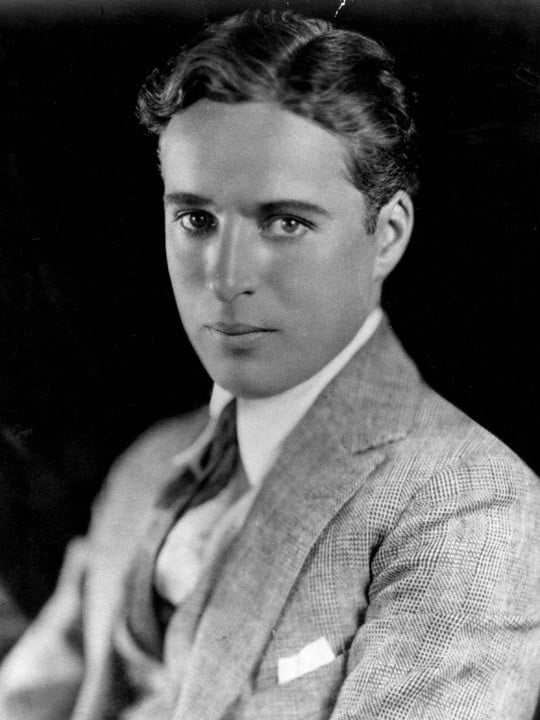
A picture of Charlie Chaplin, 1920 - By Strauss-Peyton Studio - National Portrait Gallery, Public Domain, Link
The Kid
Deriving from this traumatic experience and his own childhood memories, Charlie started filming for 'The Kid,' in which he played the role of a foster-father of an abandoned young boy. The movie became a hit and was one of the first films that combined the nuances of comedy and drama.
There are many instances when the movie touches your heart.
For instance, to make money needed for survival, the boy breaks window glasses of strangers. Then, Charlie, who casually comes along, repairs these glasses and charges money for it. This scene makes you cry by displaying how cruel poverty can be. At the same time, it makes you laugh because of the comedy that comes along with it.
Several similar scenes throughout the movie make you laugh and cry at the same time.
"The picture I want to be remembered by"
After a string of successful films under his own banner, Charlie decided that his next film should be epic. He started writing 'The Gold Rush,' which was inspired by the Donner party. It was an elaborate film, and the production cost was about one million dollars at that time.
The Gold Rush was filmed for about 15 months. It went on to become one of the highest-grossing films of its time. At the time of its release, Charlie Chaplin said that "This is the film I want to be remembered by."
Second marriage
While shooting for this film, Charlie married for the second time under similar circumstances of his first marriage. Lita Grey, a 16-year old actress, became pregnant with Charlie's child. So, Charlie married her discretely to avoid being charged with statutory rape.
It turned out to be an unhappy marriage too. Charlie had two sons with Lita before she left him. The bitter divorce that followed saw one of the highest cash settlements in the history of American courts. Charlie was deeply affected by the charges pressed on him by his wife.
While dealing with the divorce, Charlie was filming for 'The Circus.' He called the film a reminder of his troubled times. So, he even omitted this film from his autobiography. This shows how deeply Charlie was affected by the charges pressed on him by his wife.
“I always like walking in the rain, so no one can see me crying.” – Charlie Chaplin (Source)
Best Film of His Career
After 'The Circus' was released, the film industry saw the introduction of sound in movies. Charlie found the new technology absurd. He felt that the soundtrack can affect the art of acting. So, he continued working on silent films.
'City Lights,' the new movie he was working on, was based on a man who falls in love with a blind girl and raises money for her operation. It revolved around 'Tramp,' who was the central character of all his films. Charlie later confessed that he drove himself to a neurotic state to achieve perfection for this film.
City Lights reached new heights of financial success and gathered rave reviews from critics and audiences alike. It became one of the personal favorites of Charlie and remained so throughout his career.
This biography of Charlie Chaplin would be incomplete if it only mentioned his achievements and does not explain how his popularity faded in the USA.
Fading Popularity
The 1940s were a rough decade for Charlie. His life was marred by professional and personal controversies as comparisons were drawn between him and Adolf Hitler. Charlie Chaplin and Adolf Hitler were born four days apart, had both risen from poverty to world fame, and had the same style of mustache.
These comparisons made him write 'The Great Dictator,' which made fun of Hitler and his ideals. It was a great risk, but Charlie could take it because he was an independent director. After two years of writing the script and one year of production, the film became one of the highest-grossing films of that era. The movie received five academy award nominations.
Political ideology reduces public support in the USA
In the 1940s, Charlie started voicing his political opinions in his films. In 'Monsieur Verdoux' he condemned the Capitalists for encouraging war by selling weapons of mass destruction. Even though the film was a hit elsewhere, in the USA, it failed terribly.
During World War 2, he also advocated the idea of a US-Soviet partnership. So, his image in the USA was tarnished, blaming him for being a communist. Charlie, however, denied being a communist.
A paternity suit
In 1943, Charlie was slapped with a paternity suit after he refused to acknowledge the pregnancy of a budding actress named Joan Barry. Many charges were slapped against Charlie by the FBI, who wanted to damage Charlie's image after learning about his political ideologies. What followed was a bitter court battle. In 1944, Charlie was declared to be the child's father and was ordered to pay child support to the mother till the age of 21.
Just two weeks after the suit was filed, news came in that Charlie had secretly married his trainee, Oona O'Neil. This worsened Charlie's image.
Oona O'Neil was Charlie's fourth wife and remained with him until his death. They had 8 children together. Charlie described this marriage as the happiest years of his life.
The biography of Charlie Chaplin
His next film was an autobiographical film called 'Limelight.' Many of his family members worked in this film. Since the theme was set in London, Charlie decided to hold the premiere of this film there. So he left Los Angeles. But once he left the USA, his permit to re-enter the USA was revoked due to his political and moral behavior.
After being banned from the USA, Charlie Chaplin and his family settled in Switzerland. He spent the rest of his life there. Even though he did take some films, he spent most of the last two decades of his life preparing his old movies for re-release.
Awards and final works
This biography of Charlie Chaplin would be incomplete without mentioning the awards that Charlie Chaplin received. Charlie received the International Peace Prize in 1953 for his contribution to global peace and friendship among nations. However, this marred his image further in the USA as the award was given by a communist-led council.
In 1972, he received an honorary Oscar for his contribution to the film industry. It was seen as the USA welcoming back the artist after the country's political scenario changed. It was a heartfelt moment as Charlie accepted the award after a 12-minute standing ovation.
Death
Charlie suffered a minor stroke in the 1960s and was confined to a wheelchair by the mid-1970s.
In October 1977, Charlie suffered a stroke in his sleep and died at the age of 88 years.
Peace did not come to him even after his death. His coffin was stolen from the cemetery by two immigrants who held the body for ransom to extort money from Charlie's wife. The thieves were caught, and Charlie's body was re-buried in the same cemetery from which it was stolen.
Charlie's Legacy
Charlie Chaplin was one of the most influential artists of the 20th century. He was considered one of the pioneers of silent films of that era. His film-making techniques were close to perfection. He left no stone unturned in giving the best experience to his audience. Many future comedians were so inspired by him that they began to incorporate his mime sequences in their own styles.
Now his legacy is maintained by his children at the Chaplin office in Paris. His statue as "The Tramp" is situated in Leicester Square. A Soviet astronomer who discovered a minor planet even named the planet after him.
Facts you probably didn't know
- Charlie was a perfectionist who often bordered on neurotic disorders according to his own words. In the movie City Lights, he had the actress retake a shot 342 times just for saying the two words "flower, sir."
- There is an annual Charlie Chaplin Comedy Festival held in a small town in Ireland every year. People come dressed as Charlie Chaplin at the festival. There is a bronze statue of Charlie in the town as well.
- His former home in Switzerland has been converted into a museum. People from around the world gather here to get a glimpse of the artist's life up close in his own home.
- Charlie had 11 children from four marriages and received three academy awards in addition to several other honors.
We hope this biography of Charlie Chaplin helped you learn about Charlie Chaplin, his struggles and his achievements.
Whenever you think your life gets out of hand, read this biography of Charlie Chaplin. Even though he had no money and no proper family as a kid, Charlie discovered his passion. Despite all the struggles he had to undergo in life, he kept pursuing it and succeeded even when the odds were stacked against him. So, whenever you are too stressed or too depressed and can't find a reason to smile, read this biography of Charlie Chaplin and remember what Charlie said:
A day without laughter is a day wasted – Charlie Chaplin
If you liked this biography of Charlie Chaplin, you may also like this blog post:
